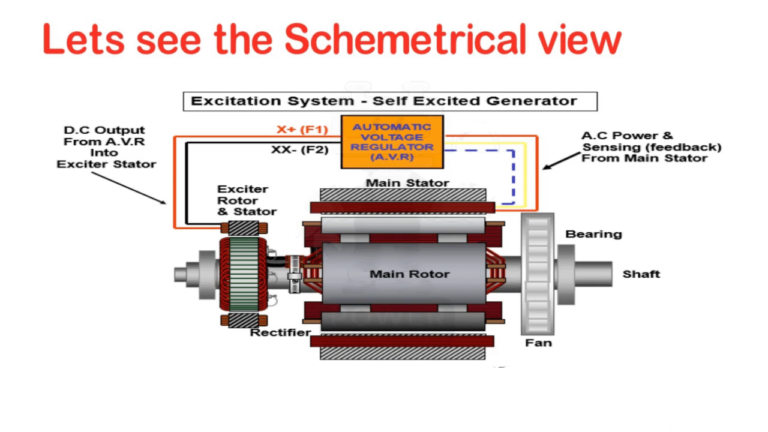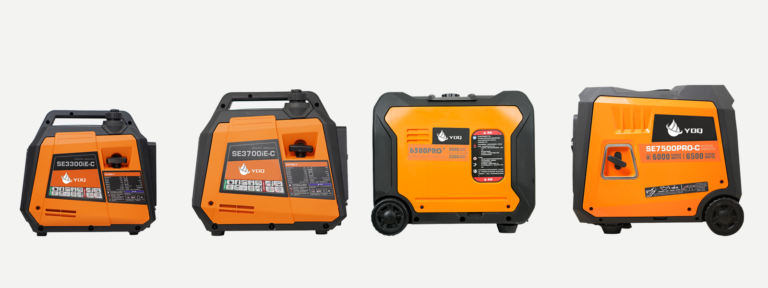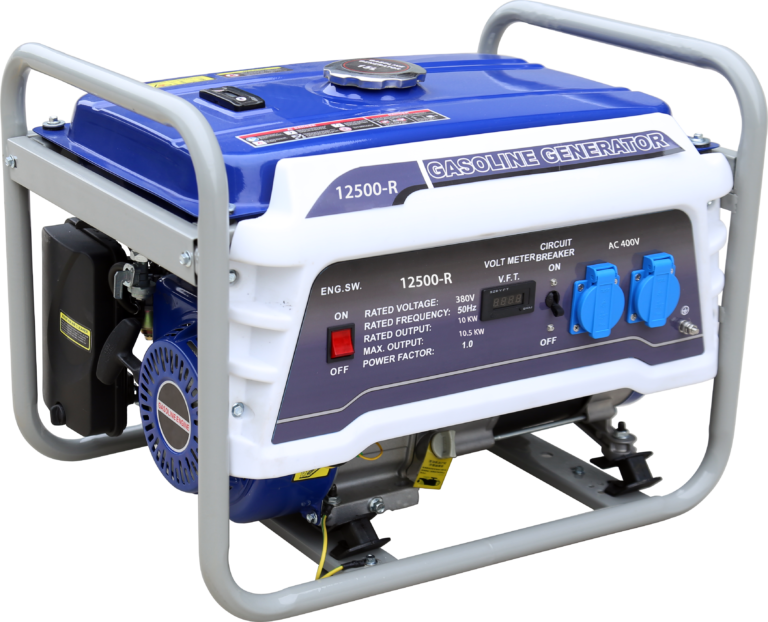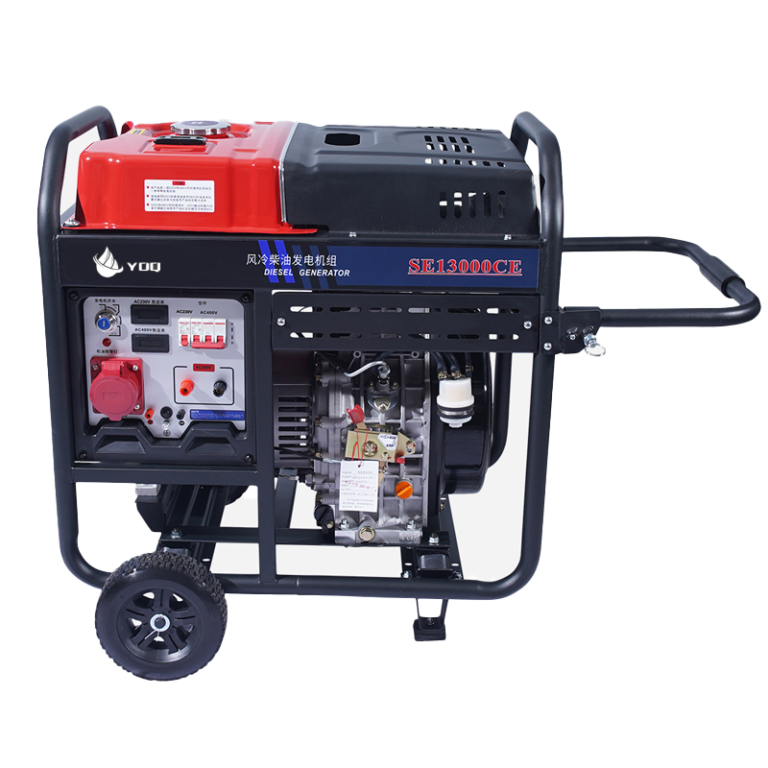Generator refers to a mechanical device that converts other forms of energy into electrical energy. It is driven by a water turbine, steam turbine, diesel engine or other power machinery. It converts the energy generated by water flow, air flow, fuel combustion or atomic nuclear fission into mechanical energy and transmits it to the generator. It is then converted into electrical energy by the generator.
Generators are widely used in industrial and agricultural production, national defense, science and technology and daily life. There are many forms of generators, but their working principles are all based on the law of electromagnetic induction and the law of electromagnetic force. Therefore, the general principle of its construction is: use appropriate magnetic and conductive materials to form magnetic circuits and circuits that conduct electromagnetic induction with each other to generate electromagnetic power and achieve the purpose of energy conversion. Generators generally consist of an alternator, a generator motor and a voltage regulator. The alternator generates alternating current, which is then converted to direct current by a voltage regulator. The generator then uses direct current to produce the required voltage.
Modern generators work on the principle of electromagnetic induction discovered by Michael Faraday in 1831-32. Faraday discovered that the above-mentioned flow of charge could be induced by moving an electrical conductor, such as a wire containing a charge, in a magnetic field. This movement creates a voltage difference between the two ends of a wire or electrical conductor, which in turn causes charge to flow, creating an electric current.
Generators are an essential part of our lives. They are used in a variety of applications, from powering our homes and businesses to providing energy for recreational activities. But how exactly do generators work? In this blog post, we’ll explore the components and principles behind generator operation, as well as the different types and benefits of generators.
What is the importance of generator?
Home power supply
The generator serves as an independent backup power supply. When the power line is cut off, the home generator can allow you to maintain power supply for ordinary household appliances and meet basic daily electricity needs.
Industrial power supply
When you need to work in remote areas or when the circuit is inconvenient, the generator can provide power supply for power tools to ensure smooth and easy outdoor work.
Outdoor power supply
As the pace of urban life accelerates, more and more people prefer outdoor camping life. Generators can provide power supply for camping peripheral equipment, allowing people to better enjoy life and experience the fun of outdoor camping.
Emergency power supply
When severe weather, natural disasters, etc. cause power outages, or during the rescue process by emergency personnel, emergency power supply can provide power supply to emergency personnel to ensure the normal operation of important equipment.
What is generator principle?
Common and widely used generators on the market are mainly diesel generators, gasoline generators and variable frequency generators.
Working principle of diesel generator
The diesel engine drives the generator to operate, converting the energy of the diesel into electrical energy.In the diesel engine cylinder, the clean air filtered by the air filter is fully mixed with the high-pressure atomized diesel fuel injected from the injector. Under the upward squeeze of the piston, the volume shrinks and the temperature rises rapidly, reaching the ignition point of the diesel fuel. The diesel is ignited, the mixed gas burns violently, expands rapidly in volume, and pushes the piston downward, which is called “work”.
Working principle of gasoline generator
The gasoline engine drives the generator and converts the energy of gasoline into electrical energy. In the gasoline engine cylinder, the mixed gas burns violently, expands rapidly in volume, and pushes the piston downward to perform work. Whether it is a diesel generator or a gasoline generator, each cylinder performs work in a certain order. The thrust acting on the piston becomes the force that drives the crankshaft to rotate through the connecting rod, thereby driving the crankshaft to rotate. By installing the brushless synchronous alternator coaxially with the crankshaft of the power machine, the rotation of the power machine can be used to drive the rotor of the generator. Using the principle of ‘electromagnetic induction’, the generator will output an induced electromotive force, and a current can be generated through the closed load loop.
Working principle of variable frequency generator
The variable frequency generator adjusts the output voltage and frequency by controlling the rotation speed of the rotor. The inverter generator receives an input of DC power, usually converted from an external DC power source by an inverter. The magnetic field within the rotor is electrically excited, causing the rotor to start spinning. The conductors on the rotor generate an induced electromotive force in the magnetic field through rotation. When the conductors on the rotor rotate in the magnetic field, alternating current is generated. The frequency of the output alternating current is proportional to the rotation speed of the rotor. By controlling the rotation speed of the rotor, the frequency of the output alternating current can be adjusted. Increasing the rotational speed of the rotor will increase the frequency of the output voltage, and decreasing the rotational speed will decrease the frequency. The inverter can adjust the voltage of the output AC power as needed. By controlling the output voltage of the inverter, voltage regulation can be achieved. The adjusted alternating current is introduced into the output port of the generator and supplied to external equipment or electrical systems to meet the needs of various application scenarios.
In this way, the variable frequency generator can flexibly adjust the output voltage and frequency as needed to meet the power needs of different application scenarios.
What are the basic components of a generator?
The basic structure of a generator includes the following main components:
Rotor
The rotor is the rotating part of the generator, usually made of electromagnets or permanent magnets. The rotor is usually mounted with a set of conductors, often called windings or field coils. When the rotor rotates mechanically, the conductors move in the magnetic field, creating an induced electromotive force.
Stator
The stator is the stationary part of the generator and is usually fixed within the casing of the generator. The stator is also equipped with a set of conductors arranged in a specific geometry and interdigitated with the conductors on the rotor. As the rotor rotates, the current in the stator conductors creates a magnetic field that interacts with the magnetic field on the rotor to create an electromotive force.
Excitation System
The excitation system is used to provide the main magnetic field of the generator. It can be a DC power supply that generates a magnetic field through an excitation coil or an electrically excited electromagnet. This magnetic field enables the rotor to rotate in it and induces an electromotive force in the rotor conductors.
Conductors
Conductors are materials used to conduct electricity, usually copper or aluminum wire. Conductors are installed in the wire ducts of the rotor and stator, and they are responsible for transmitting the induced electromotive force to the external circuit to form the output current.
Cooling System
Generators usually generate a certain amount of heat, so a cooling system is required to maintain their normal operating temperature. The cooling system can be air-cooled or water-cooled and is used to cool the windings and other critical components of the generator.
Control System
The control system is responsible for monitoring and regulating the operating status of the generator. It can include voltage regulators, frequency regulators and protection devices, etc., to ensure that the generator can operate safely and stably under various working conditions.
These components work together to convert mechanical energy into electrical energy and output it to power external circuits. The basic makeup of a generator enables it to provide reliable power supply in a variety of applications.
How does generator work step by step?
The operation process of a generator mainly consists of the following steps, which can generally be summarized as the main process of converting mechanical energy into electrical energy.
Magnetic field generation
The excitation system inside the generator produces a stable magnetic field. This magnetic field can be provided by an electrically excited electromagnet or a permanent magnet, which creates a persistent magnetic field environment.
Conductor movement
A generator has a set of conductors mounted on its rotor, and when the rotor rotates mechanically, the conductors move in a magnetic field. This motion can be in the form of rotation, swing or linear movement, but it must have a certain relative motion relative to the magnetic field.
Electromagnetic induction
According to Faraday’s law of electromagnetic induction, when a conductor moves in a magnetic field, an induced electromotive force is generated. This is because when a conductor cuts magnetic field lines in a magnetic field, it causes the charge inside itself to move, thereby generating an electric field, which ultimately leads to the generation of induced electromotive force.
Generation of induced current
The induced electromotive force generated drives the free electrons inside the conductor to move, thus forming an induced current. This induced current is the current output by the generator, which can flow in the wire and be supplied to the external circuit.
Adjustment of output voltage
By adjusting the magnetic field strength provided by the excitation system, the magnitude of the induced electromotive force can be controlled, thereby adjusting the output voltage of the generator. In this way, the output voltage can be adjusted as needed to meet the working requirements of different electrical equipment.
To sum up, the operation process of a generator involves key steps such as magnetic field generation, conductor movement, electromagnetic induction and induced current generation. This process converts mechanical energy into electrical energy and outputs it to power external circuits.
What are the application of different types of generator?
Generators can be divided into diesel generators, gas generators, gasoline generators, wind generators, solar generators, hydroelectric generators, coal-fired generators, etc. according to different power sources.And according to the style classification, it can be divided into open-frame generators and silent generators. Here we mainly talk about diesel generators,gasoline generators, and inverter generators.
The application of diesel generator
Diesel generator is a small power generation equipment with the advantages of flexibility, low investment, and can be started at any time. It is widely used in small and medium-sized enterprises such as industry, commerce, schools, hospitals, etc. for long-term (temporary) power consumption; generator sets, construction machinery , ships and other fixed power, as well as communications, mining, road construction, forest areas, farmland drainage and irrigation, field construction and national defense engineering and other departments.
Diesel generator is also a kind of AC power supply equipment in self-provided power stations. It is suitable for communication bureau stations, mining areas, forest areas, pastoral areas and national defense projects that cannot be delivered to the mains power grid. It is required to be able to provide independent power supply as the main power source for power and lighting. For areas with mains power supply that require high power supply reliability and do not allow power outages or units that require power supply to be restored quickly within a few seconds (such as communications, banks, hotels and airports), diesel generators can also be used as backup emergency power sources. In the event of a power outage, stable AC power can be quickly provided.
The application of gasoline generator
Gasoline generator sets in telecommunications systems are usually used for emergency communications, emergency repairs, or backup power for small access network computer rooms and computer rooms. Gasoline generator sets are used under the following circumstances:
In the event of natural disasters, such as heavy rain, floods, etc., huge diesel units cannot be transported, and lightweight gasoline units are the best choice to ensure power supply for communication equipment in disaster areas;
When the mains power is unstable or has a power outage, a small access network computer room or station can use a gasoline generator set as a backup power source;
During emergency repairs, if the emergency repair personnel need to carry backup power, they can use gasoline generator sets (of course, if the power consumption is large, a mobile diesel generator set is required).
At the same time, generators are also commonly used in daily household backup power supplies, as well as to provide power for peripheral products at construction sites, commercial uses, or when camping.
The application of inverter generator generator
Due to its adjustable voltage and frequency and stable output, inverter generators are suitable for a variety of scenarios that require high power quality and adjustable voltage and frequency.
Medical equipment
Medical equipment has extremely high requirements on power quality and requires stable voltage and frequency. Inverter generators can provide high-quality power supply to ensure the normal operation of medical equipment.
Computers and IT Equipment
Computer systems and other IT equipment require very high power stability to avoid data corruption or system crashes. Inverter generators can provide stable power and ensure the safe operation of computer systems.
Precision instruments
Many precision instruments have extremely high requirements on the stability and accuracy of power supply, such as laboratory equipment, measuring instruments, etc. Inverter generators can provide high-quality power to ensure the accurate operation of precision instruments.
Electronics manufacturing industry
The electronics manufacturing industry has high requirements for the stability and adjustability of power supply to ensure the smooth progress of the production process and the stability of product quality. The inverter generator can adjust the output voltage and frequency as needed to meet the special needs of the electronics manufacturing industry.
Camping
The inverter generator has very low noise, is light in weight, small in size, and easy to carry. It is the best choice to provide power for surrounding equipment when camping.
Safety precautions when using a generator
1. Always follow the generator manufacturer’s instructions for safe operation.
2. Always use the generator outdoors in a well-ventilated area.
3. Maintain the generator engine according to the maintenance schedule to maximize its performance and ensure safety.
4. Never use the engine near flammable materials.
5. Always use new gasoline. If you don’t plan to use the generator for longer than 30 days, add gasoline stabilizer to stabilize the gasoline.
6. Please place the generator on a flat ground for operation.
7. When using an extension cord, make sure it is grounded and its wire size is sufficient to meet the requirements of use. High-power outdoor dedicated wires can withstand the load requirements of household appliances.
8. Never connect the generator directly to your household electrical circuit.
9. If you want to connect a generator to your home’s electrical system, you must have an emergency manual power transfer system installed by a qualified electrician.
How to maintain generators?
daily
1) Check the generator working daily report.
2) Check the generator: oil level, coolant level.
3) Daily check whether the generator is damaged or leaked, and whether the belt is loose or worn.
weekly
1) Repeat daily A-level inspections.
2) Check the air filter, clean or replace the air filter element.
3) Drain the water or sediment in the fuel tank and fuel filter.
4) Check the water filter.
5) Check the starting battery.
6) Start the generator and check if there is any influence.
7) Use an air gun and clean water to clean the heat sinks at the front and rear ends of the cooler.
Level B maintenance
1) Repeat Level A daily and weekly inspections.
2) Replace the generator oil. (Oil change interval is 250 hours or one month)
3) Replace the oil filter. (The oil filter replacement cycle is 250 hours or one month)
4) Replace the fuel filter element. (Replacement cycle is 250 hours or one month)
5) Replace the coolant or check the coolant. (The replacement cycle of the water filter element is 250-300 hours. Add water to the cooling system.
6) Clean or replace the air filter. (The air filter replacement cycle is 500-600 hours)
Level C maintenance
1) Replace the fuel filter, oil filter, water filter, and replace the water and oil in the water tank.
2) Adjust the fan belt tension.
3) Check the supercharger.
4) Disassemble, inspect and clean the PT pump and actuator.
5) Remove the rocker arm chamber cover and check the T-shaped pressure plate, valve guide and intake and exhaust valves.
6) Adjust the lift of the oil nozzle; adjust the valve clearance.
7) Check the water tank radiator and clean the external radiator of the water tank.
8) Add water tank treasure to the water tank and clean the inside of the water tank.
9) Check the diesel engine sensor and connecting wires.
10) Check the diesel engine instrument box.
Generators play an important role in our daily lives as backup power sources. As a home backup power source, generators can provide continuous power supply during power outages to ensure the normal operation of family life. At the same time, generators play an important role in industrial production, providing stable power for various equipment and supporting factory production operations. Commercial institutions, medical institutions, communication base stations and other places that require stable power supply often rely on generators to provide power support. In situations such as camping, outdoor activities or field construction, generators can provide power support for tents, lighting equipment, electric heating appliances, etc.
In the future, generators may integrate more renewable energy sources, such as solar energy, wind energy, etc., to achieve a more environmentally friendly and sustainable power generation model. With the development of intelligent technology, future generators may be more intelligent, equipped with remote monitoring, automatic adjustment and other functions to improve operating efficiency and stability. As energy storage technology advances, future generators may incorporate more advanced battery technology to achieve longer periods of continuous power supply and higher energy utilization. Generators in the future may be more miniaturized and portable, making them more suitable for outdoor activities, emergency rescue and other scenarios, and providing greater convenience to people’s lives.











